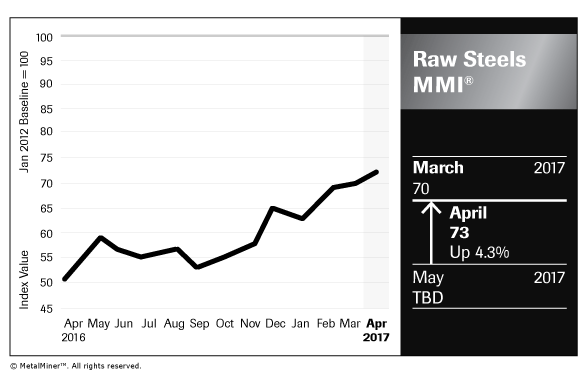Our Raw Steels Index rose 4.3% in March. Steel prices in the U.S. resumed their upward trend, with products like cold-rolled coil hitting a five-year high. However, not everything was bullish in March. Prices in China fell sharply. Let’s look into this U.S.-China price divergence:
Trump’s Rally
U.S. steel prices have been on a joyride since Donald Trump won the U.S. presidential election. Markets’ reaction to the election results wasn’t really surprising given the president’s stance on curbing imports and boosting domestic infrastructure.
The Trump effect wasn’t the only factor driving this rally but it definitely helped prices to accelerate. However, markets now wonder if Trump can deliver what he pledged.

In March, officials said an executive order approving two pipeline projects and mandating the use of American-made steel won’t apply to the construction of the Keystone XL oil pipeline, contradicting prior statements by Trump that it would. A spokesperson for the administration said Keystone XL was grandfathered even though almost all of it has yet to even begin pre-construction.
In addition, Trump has so far failed to get his healthcare bill through Congress. After the healthcare failure, markets now question if Trump will get Congress to approve spending of large sums on the infrastructure sector, too.
China’s Prices Fall
In our view, falling Chinese steel prices are a bigger risk for U.S. steelmakers compared to the concerns over President Trump’s proposed infrastructure investments. Currently, China isn’t a major exporter to the U.S., but Chinese steel prices impact steel prices all over the world, as they put a floor under international steel prices.
Chinese hot-rolled coil (HRC) prices have fallen almost 15% since their February 2017 highs. March’s divergence has made U.S. prices expensive again relative to Chinese prices. In the case of cold-rolled coil, the price spread has now widened to $350 per ton, which is high compared to historical levels.
The conclusion is that for this rally in U.S. steel prices to continue, we would need to see rising prices in China as well. This is something we’ll be monitoring closely in the next few weeks. The biggest risk for the U.S. steel industry could be a further slide in Chinese steel prices. Even infrastructure spending may not be of much help in that case.
